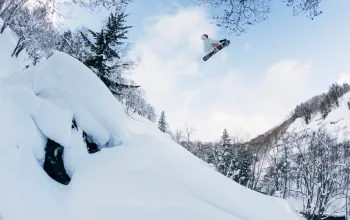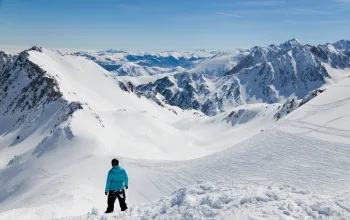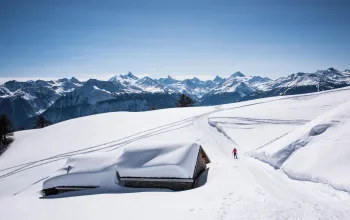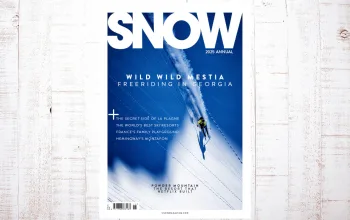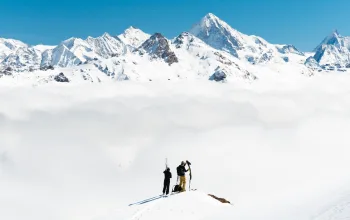Every week during the ski season thousands of people head out to resorts to learn to ski. Maybe you're having some private lessons, or, more likely you're booked in for group lessons at ski school. Either way, before heading out to the mountains for your first ski holiday, it's a good idea to have a few skiing lessons at a dry ski slope or indoor snow dome in the UK first. This will speed your progress once you get out to the mountains and enable you to make the most of the resort ski area.
Dry ski slopes are a good value way for a beginner to learn the basics and will always stand you in good stead when you eventually make it onto a real snow slope. After all, they were good enough for Olympians such as Dave Ryding and Billy Morgan!
But more and more people are opting to learn to ski at one of the UK's indoor snow centres, such as Snozone in Castleford or Milton Keynes, the Snow Centre at Hemel Hempstead, Chill Factore in Manchester, the Snowdome at Tamworth or Ski Factor in Glasgow. All offer brilliant experiences that will set you up for your ski holiday. From putting on boots to your first snow plough, here's what to expect.

Get to grips with ski gear
Whether you're having private ski lessons or a group lesson, aim to arrive up to 40 minutes early to check in, collect your rental equipment and get changed. If you don’t have any ski kit, you can always hire a ski jacket and salopettes at the venue. You'll need gloves and long ski socks, or you can buy them at the centre’s shop.
Ski goggles are not needed indoors. Skis, boots, poles and helmets are included in the lesson price. A technician will ask you your height, weight and shoe size - this is so the equipment can be set up correctly for you. Your height helps determine the length of ski or board you’re given, and ski or snowboard boots will be the same size as your normal footwear.
Knowing your weight helps the technician to set the binding on the ski (the fixing that holds you into the ski), so that if you take a twisting fall the ski will come off easily.
Meet your ski coach
Next, you’ll be directed to a waiting area to meet your ski or snowboard instructor, who will introduce themselves and explain what to expect from your lesson to help settle any nerves and answer any questions you have.
This is also a good time for you to tell your coach if you have any medical issues that may be relevant. It’s worth remembering that your instructor will be a fully qualified expert skier who has gone through a training programme and will only be allowed to take a class once he or she has passed stringent tests.
Get to know your skis
Before you start skiing you will need to get used to walking in your boots. Ski boots are a little trickier to manage than snowboard boots, which are much softer and more comfortable at first than ski boots. Your instructor will also show you the safest way to carry your skis or board.
Once on the snow, you’ll be shown how to get into your skis or snowboard. Skis have a simple step-in binding system, while snowboard boots strap in to the binding on your board. If you’re skiing you’ll also have poles with you, which are chosen to suit your height.

Getting started
Now comes the actual skiing lesson. The beginner’s area of an indoor ski centre is a shorter nursery slope set apart from the main slope used by more experienced skiers, and used specifically for teaching complete beginners. One of the first exercises you’ll try will be to get you used to moving forward in skis or getting up on your board on a flat part of the slope.
Other typical basic movements include sliding your skis back and forth whilst stationary, lifting one ski and then the other, and getting the hang of walking sideways or walking with one binding out for snowboarders. You should progress to sidestepping, learning to use the edges of your skis to grip the snow as you step sideways up the slope. You will also be introduced to using the beginner ski lift.
Learn the skiing basics
Before you even try to slide down the slope, your instructor will give you helpful tips and advice to help you achieve the right posture and balance on your skis or board. The basic ski position is a kind of crouch, like a goalkeeper waiting for a penalty kick.
Your first descent will be short, and at this stage skiers will be told to keep skis angled towards each other in a V-shape. This is the basic snow plough, and is your go-to position while you learn to control speed and come to a stop. You will practice this skiing technique until you’re comfortable with it. Similarly, snowboarders will learn to side slip on their toe edge and heel edges.

Master the ski lifts
Depending on the length of your session, you may move across to the main slope, and this will mean riding on a button lift. Pretty much everyone has fallen over on a button lift at some point, so don’t feel embarrassed if you do too. If (when!) it happens, the lift operator will stop the lift, giving you time to get back up again.
Your coach will demonstrate how to get onto the lift, which involves grabbing a button-shaped seat on a steel pole and sticking it between your legs - the lift then drags you up the mountain with your skis or board still on the snow.
Moving on
Whatever your age and fitness, hopefully, your first turns will go well and you'll want to keep going. The UK's snow centres offer a structured course of skiing and snowboarding lessons to help you develop your confidence and learn new skills such as linking turns and carving in a controlled environment.

Learn the lingo
How to decipher the weird and wonderful vocabulary of a ski resort...
Backcountry: Skiing on unmarked and unpatrolled areas outside of the ski resort boundaries.
Bluebird: A day with a bright blue cloudless sky after heavy overnight snowfall – the perfect day to seek ‘pow’.
Corduroy: When piste bashers leave behind a pattern of small ridges in the snow that appear like corduroy fabric.
Freeride: Skiing or boarding on open, un-prepared terrain, away from slopes and usually in powder snow.
Freestyle: Freestyle is all about air and ground tricks, often in the park or on jumps around the mountain.
Freshies: Untouched powder. Getting ‘freshies’ involves being the first person to ski through an area of fresh snow.
Piste-basher: A ‘piste-basher’ is a tracked vehicle that ‘grooms’ a ski hill leaving perfectly prepared pistes.
Moguls: Bumps on a piste that are formed when skiers push snow into mounds as they make their turns.
Off-piste: Basically all the snow that is not on the piste from the ungroomed stuff just off the edge, to full-on powder fields
Park: Or snow park – a purpose-built area for skiers and boarders to practise tricks on rails, boxes, and various sized jumps.
Powder: Or ‘pow’ – the perfect fine, dry and lightweight snow found after a fresh fall.
Ski-in, ski-out: Accommodation that’s right on the piste – so you can literally ski back to and from the door.
Vertical Drop: The vertical distance from the top to the bottom of a mountain or ski slope.
Whiteout: When visibility on the mountain is severely reduced due to heavy falling snow or thick fog.
About Snozone
Snozone have three centres; two real indoor snow centres - one in Castleford, Yorkshire and one in Milton Keynes, Buckinghamshire. They also run an indoor dry slope in Basingstoke. Snozone provide private, group or family ski and snowboard lessons with BASI qualified Coaches on real snow, giving you an authentic way to get used to being on the slopes in a safe and relaxed environment. Lessons start at £35.99 for adults for a level 1 introductory lesson. Your gear (helmets, boots and skis or board) is included in your ticket price. Snozone are also the only European operator to have their own disability snow school and offer adaptive ski lessons at their venues.
snozoneuk.com







